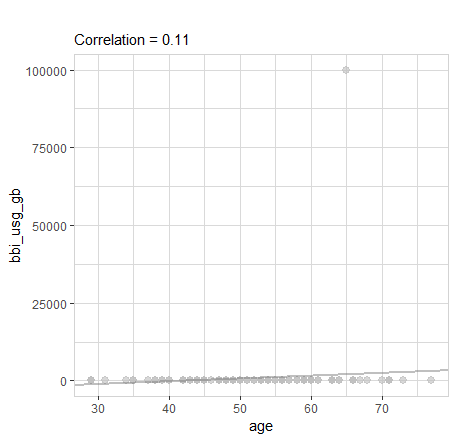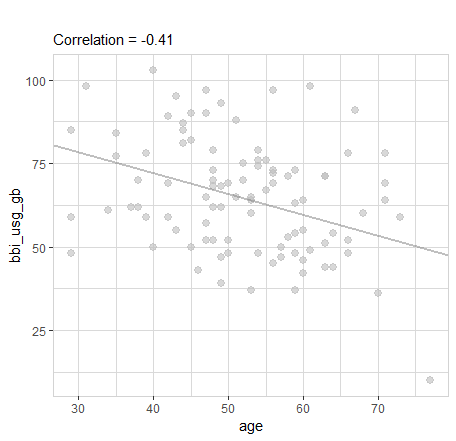Deal with extreme values
{explore} the missleading power of extreme values!
Data
In this example we are using a dataset from {explore}
library(tidyverse)
library(explore)
data <- use_data_buy(obs = 100)
We get a dataframe with 100 observations and 13 variables:
data |> describe()
# A tibble: 13 × 8
variable type na na_pct unique min mean max
<chr> <chr> <int> <dbl> <int> <dbl> <dbl> <dbl>
1 period int 0 0 1 202012 202012 202012
2 buy int 0 0 2 0 0.53 1
3 age int 0 0 41 24 52.6 92
4 city_ind int 0 0 2 0 0.49 1
5 female_ind int 0 0 2 0 0.53 1
6 fixedvoice_ind int 0 0 2 0 0.08 1
7 fixeddata_ind int 0 0 1 1 1 1
8 fixedtv_ind int 0 0 2 0 0.43 1
9 mobilevoice_ind int 0 0 2 0 0.68 1
10 mobiledata_prd chr 0 0 3 NA NA NA
11 bbi_speed_ind int 0 0 2 0 0.6 1
12 bbi_usg_gb int 0 0 56 10 1064. 100000
13 hh_single int 0 0 2 0 0.29 1
Hypothesis
Let’s say, there is a hypothesis, that the higher the age, the higher the broadband internet usage in gigabyte (bbi_usg_gb).
We can simply calculate the correlation between age and bbi_usg_gb:
cor(data$age, data$bbi_usg_gb)
[1] 0.105514
We get a positive correlation. So did we just proof that the hypothesis is correct?
Let’s take a closer look:
Explore
We can visualise the correlation between age and bbi_usg_gb by using the explore() function.
data |> explore(age, bbi_usg_gb)

There is one single observation with a crazy high internet usage (1 Mio Gigabyte). What will happen, if we exclute this extreme value from the data?
data |>
filter(bbi_usg_gb < 100000) |>
explore(age, bbi_usg_gb)

This made the correlation flip from a positive value to a negative value.
Conclusion
Never trust a correlation, always take a closer look to the data.
Use visualisations to check patterns in data, and double check with someone who has domain knowlege, if it realy makes sense.
Wanna try by yourself? Use https://github.com/rolkra/explore (you need {explore} 1.3.1 or higher)